The Newbie's Guide to Marketing OKRs (with Examples)

Exorbitant acquisition channels. Increased ad spend. Budget cuts.
These challenges are going through an upward trend in marketing, and it's never been more important for you to work on campaigns that...well, work.
In marketing speak, OKRs is a goal-setting framework where you set marketing goals and achieve them in a time frame.
OKRs are far from solving these knotty issues, but when set right, they can help you stay the course and raise your chances of accomplishing your goals.
- What are OKRs in Marketing?
- What's the Difference Between OKRs and KPIs?
- 5 Marketing OKRs Examples
- How to Track Marketing OKRs with DashThis
- Automate Your OKR Reporting Today
What are OKRs in Marketing?
Marketing OKRs is a goal-setting methodology where marketers set goals and achieve them within a period. In marketing speak, OKRs stand for:
- Objectives: High-level company goals that set the motion for marketing initiatives
- Key Results: 3-5 outcomes (for each objective) that show how you achieve said goals
🤔 Why does OKR reporting matter in marketing?
Last year, advertisers wasted an eye-watering amount of $123.1 million in digital ads, a figure up $25 million from last quarter's.
And that's just ads...in Australia alone.
With the ad spend wastage trend line moving upwards, it has never been more important to keep a close eye on your marketing campaigns and ensure you're making the most of every dollar.

[Data via DashThis] The eye-catching graphs, along with the upward (green) and downtrend (red), helps you gauge if you've achieved your OKRs — at a single glance
This is why the OKR framework matters. It keeps you focused, aligned, and united on shared business objectives — increasing your chances of succeeding your marketing goals.
What's the Difference Between OKRs and KPIs?
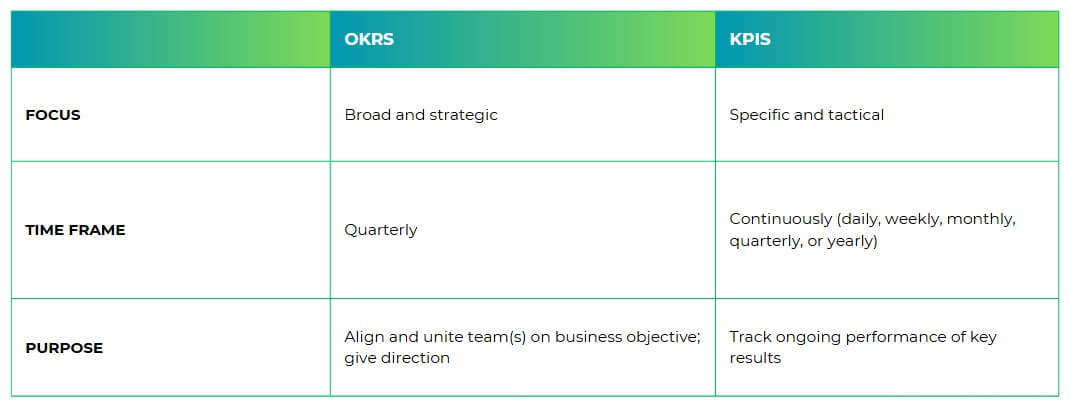
OKRs are often confused with KPIs.
And it's not hard to see why.
KPIs, which stand for key performance indicators, are a set of metrics that track the performance of your marketing efforts (often, these are the key results in your OKRs).
As you can see here, there is a bit of an overlap.
In any case, here are the differences between an OKR vs KPI:
(i) Focus: OKRs are broad and strategic. Think of them as a "big picture" roadmap. On the other hand, KPIs are specific and tactical. They're standalone metrics that measure day-to-day operations.
(ii) Time frame: OKRs are often set for the quarter, while KPIs are measured continuously.
(iii) Purpose: OKRs provide direction; they align and unite teams on a shared business objective. Whereas KPIs measure ongoing performance.
How to track OKRs and KPIs simultaneously (for different purposes)
It's not an either-or situation.
Ideally, you should track both OKRs and KPIs in a marketing strategy.
While OKRs keep your team focused and aligned on a goal, KPIs measure how far off you are in achieving it.
Let's illustrate this with an example. Imagine you work in a demand generation agency that wants to expand its total addressable market (TAM). Your new target group is startups in the HR and finance industries.
Here's how marketing + sales might set the OKR performance and KPIs*:
OBJECTIVE: Acquire leads in new inbound strategy
Key Result 1: Increase number of inbound leads by 20% in Q2
Key Result 2: Convert leads to appointments by 10% in Q2
Key Result 3: Increase number of followers on LinkedIn to 2,000 in Q2
KPIs:
- New leads in pipeline
- Conversion rate
Metrics:
- Click-through rate (CTR) for PPC and email campaigns
- Number of marketing-qualified leads (MQLs)
- Number of sales-qualified leads (SQLs)
- Lead-to-appointment rate
- Number of impressions, unique views, clicks, reactions, comments, reports, and engagement rate on LinkedIn
*This list is by no means exhaustive
💡Pro tip:
Here are three tips to measure your OKRs and KPIs efficiently.
(i) TOOLS
Connect your entire data from multiple marketing channels into one report via DashThis. This lets you visualize and analyze your data in one place, speeding up reporting and decision-making.
Note this all-in-one social media report. It combines Facebook, Instagram, TikTok, LinkedIn, and YouTube in one report. Within seconds, you can tell if you've achieved your target.
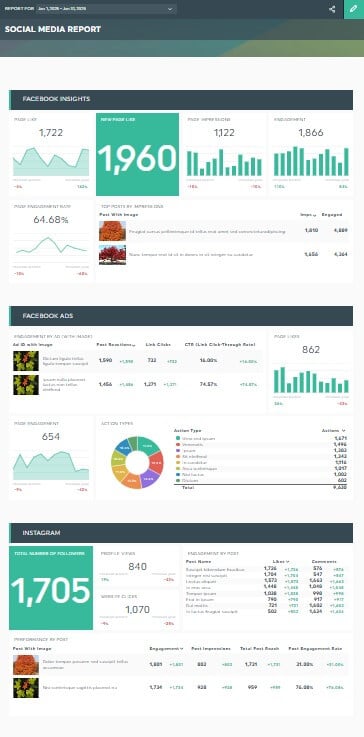
(ii) REPORTING
Although it's not a must, it's ideal to create separate reports for your OKRs and KPIs. Learn how to accomplish this in our step-by-step tutorial here.
(iii) FREQUENCY
Monitor KPIs regularly, while reviewing OKRs at the end of each quarter. This ensures everyone achieves their milestones well ahead of time.
5 Marketing OKRs Examples
This is what you're here for! If you're struggling to set marketing OKRs for the first time, use the digital marketing OKRs examples below as a starting point.
Example 1: Expand brand awareness

Brand awareness is notoriously hard to track because there's no metric that directly measures brand recall, brand recognition, etc. Fortunately, it is possible to gauge your impact by looking at these trends.
OBJECTIVE: Increase brand awareness in target markets
Key Result 1: Grow social media followers by 20%
Key Result 2: Increase total number of branded keywords searches on search engine by 11%
Key Result 3: Raise Share of Voice on social media by 6%
Example 2: Acquire high-quality leads

Revenue is lagging behind projections and the higher-ups are pressuring you to develop a new customer acquisition strategy. Where should you begin? Start with building a scalable lead generation machine.
OBJECTIVE: Generate high-fit leads from new ideal customer profile (ICP)
Key Result 1: Increase number of leads through inbound marketing by 20%
Key Result 2: Improve number of MQLs by 10%
Key Result 3: Raise new white paper lead magnet's conversion rate by 15% to grow email subscribers list
Key Result 4: Nurture MQLs to SQLs by 3-5%
Key Result 5: Grow number of closed won deals by 3% to generate new customers
Example 3: Engage customers

Retention is just as important as customer acquisition.
To retain customers, engage them in the post-purchase experience.
Whether it's entrusting dedicated customer success managers to manage bigger accounts or offering your agency's proprietary tools at no additional charge, these marketing OKRs keep you on track.
OBJECTIVE: Improve customer engagement to reduce churn
Key Result 1: Improve open rate by 45% for ongoing post-purchase email sequence.
Key Result 2: Improve our net promoter score (NPS) > 75
Key Result 3: Launch a new product marketing strategy to promote new tools developed at our agency
Example 4: Boost qualified website traffic

Attracting qualified traffic starts with building demand in your target markets. Once you've developed a scalable system across the entire funnel, you'll generate high-fit website visitors and convert them to prospects, and ultimately, customers.
OBJECTIVE: Increase qualified and high-fit website traffic
Key Result 1: Achieve a 30% increase in organic search traffic
Key Result 2: Reduce bounce rate by 15%
Key Result 3: Generate 35% more referral traffic
Key Result 4: Increase number of active users by 20%
Key Results 5: Improve web traffic by 40% from organic social media marketing
Example 5: Optimize content marketing efforts

Successful content compels customers to take action. Whether you're creating content to grow an email list, generate leads, or support sales, here are several OKRs you might include in your content marketing reporting dashboard.
OBJECTIVE: Improve content strategy to drive profitable customer action
Key Result 1: Grow 2,500 subscribers in email marketing strategy
Key Result 2: Generate 200 new backlinks from industry blogs
Key Result 3: Achieve 25+ first page rankings for bottom-of-the-funnel (BoFu) keywords
Key Result 4: Drive 100+ leads from search engine optimization (SEO) blog posts
Key Result 5: Start partnerships with 20 industry experts and influencers to create thought leadership content
How to Track Marketing OKRs on DashThis
Multiple sources show that the average team can handle up to three objectives with 3-5 key results each. Why this figure? Because it ensures every member is focused on the goal without feeling overwhelmed.
With that many OKRs to track, your agency needs a highly efficient process.
Consider automating it on DashThis.
It’s the easiest OKR software that gathers your entire data across multiple marketing channels into one report, automatically.
Free up hours of your time for more billable work. Like reflecting on what you've accomplished in your marketing OKRs as a team and brainstorming the next top-line OKRs in the next quarter.
Here's how automating an OKR dashboard looks like on DashThis:
- Select a free OKR template
- Connect your channels with DashThis
- Pick your KPIs or metrics in Preset Widgets
Hang tight a few seconds while DashThis collects data into your dashboard, automatically. Drag and drop the widgets to form a cohesive look.
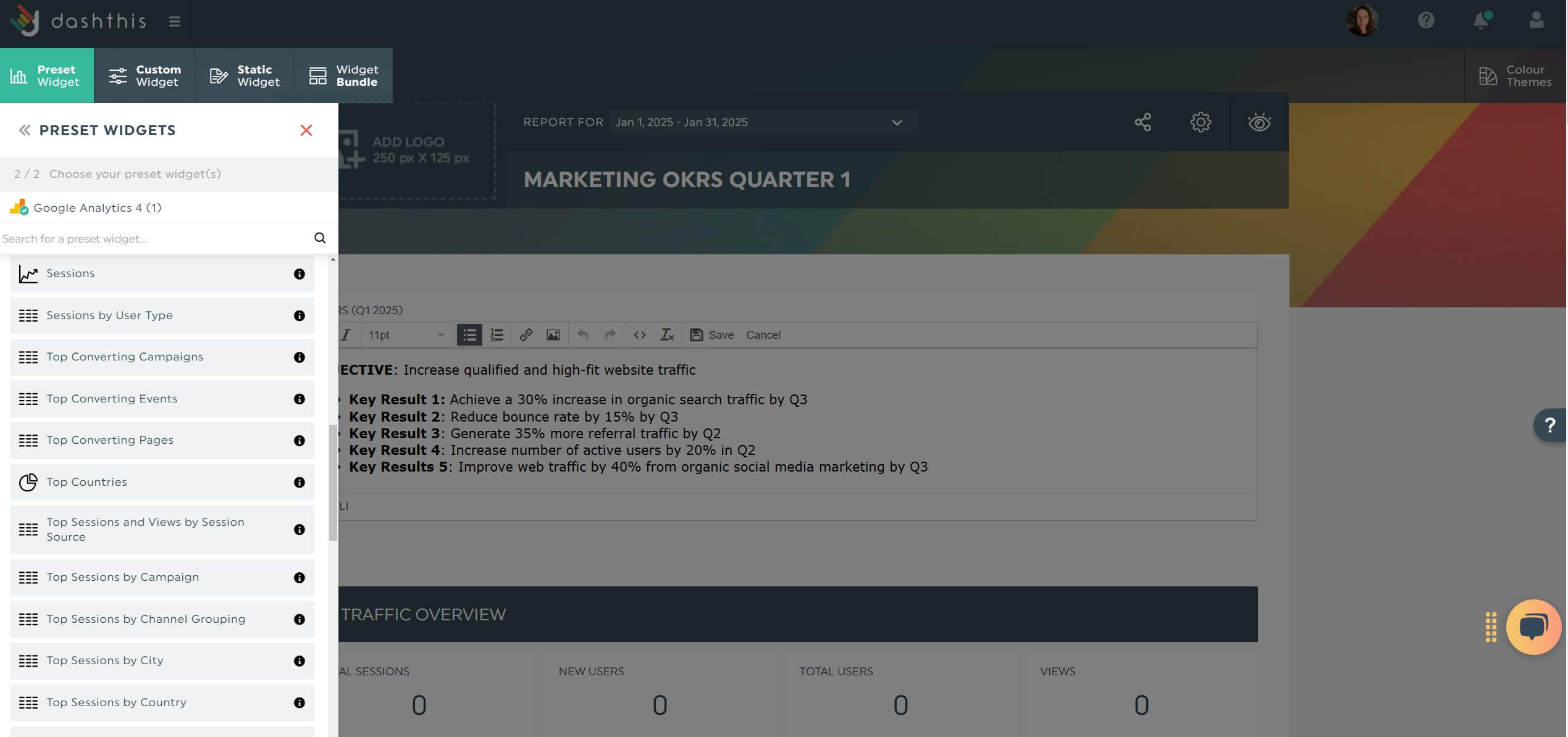
Tailor the report accordingly.
For example, it's best practice to spotlight the current OKRs at the top of the dashboard. This helps you set the stage and reiterate the top-line goals.
Click Static Widget > Comments.
Include the marketing OKRs and click Save.
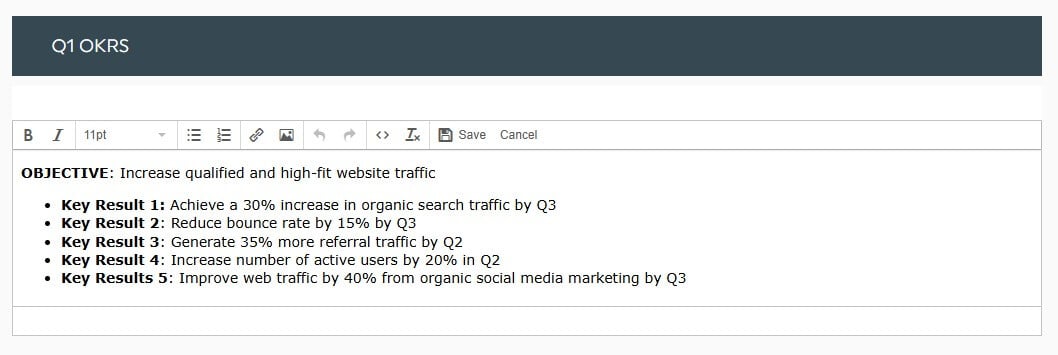
Pepper the report with more comment boxes to summarize the quarter's OKRs. For example, you might give each key result a score (on a scale from 1-3; with 3 being the best) and share how you plan to move forward in the next quarter.

Customize the report further according to your target audience.
Let's imagine you're presenting to a busy CMO. In this case, you'll want to make your report as value-packed + digestible as possible.
Our suggestion? Include built-in notes directly in the report. This note will appear as a visible orange tab in view mode and allow the busy CMO to review everything that's important — in one place.
Here's how it works. Hover to a widget you want to provide context and click Add Note.
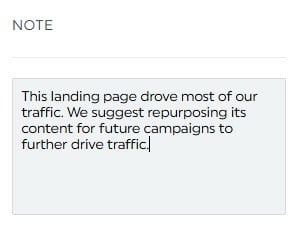
Here's how it might look when you provide context for a top-performing landing page
Click Save.
Repeat the same steps if you want to create a separate report for your KPIs — only this time focusing on metrics that impact day-to-day operations.
Setting OKRs takes practice.
In fact, it may take a few quarters for your team members to get the hang of it. If your current OKRs went wrong — say the marketing team set an unclear objective and it was doomed before launch — try DashThis.
With all marketing OKRs, insights, and recommendations in one report, it's easier to spot mistakes, set data-driven decisions, and get the next OKRs back on track.
Once you’ve completed your marketing OKRs report, set an automatic email dispatch:
- Hover over the Sharing Options icon in the top right
- Click Share by Email
- Set the dashboard period and frequency
- Add an optional note
- Click Schedule
Automatically send your report based on your preferred schedule. Everyone (i.e., owner of each marketing OKR) receiving this dispatch can view the report in real-time.
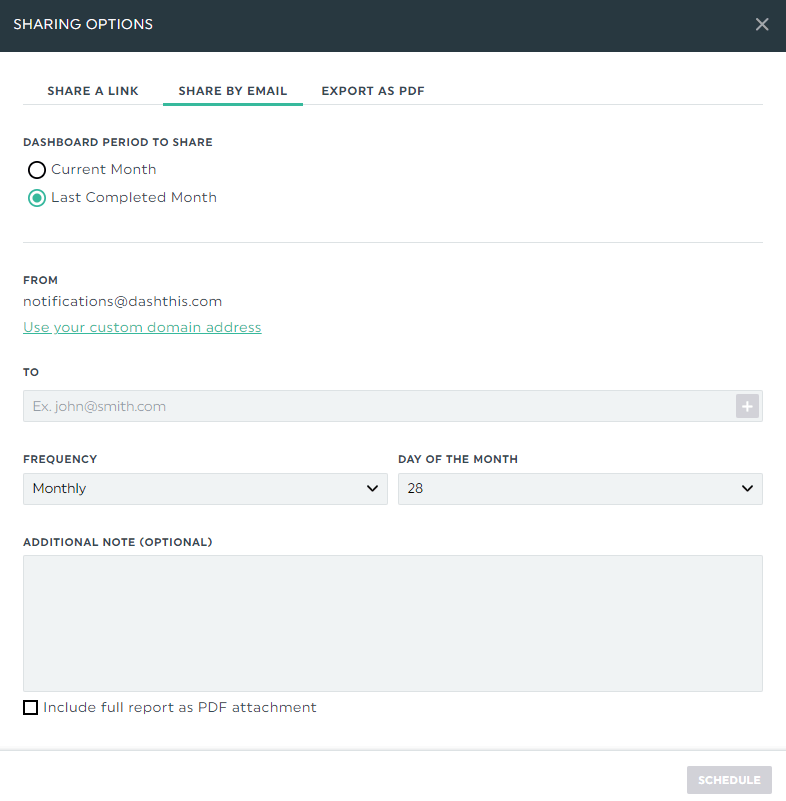
DashThis is the easiest OKRs reporting tool. Start your free 15-day trial today.
Automate Your OKR Reporting Today
It takes time to get the hang of your marketing OKRs. Go ahead and bookmark this guide for easier reference. While the examples shouldn't be used verbatim, they do work well as a starting point.
Get aligned with your team when setting the OKRs. It'll keep everyone united on a shared business objective and increase your chances of accomplishing it.
And while you’re at it, automate your OKR reporting with DashThis.
DashThis is the easiest OKR software reporting tool that gathers your entire data across multiple marketing channels into beautiful one report, automatically. Pricing starts at $42/month when billed annually.
Start tracking your marketing OKRs with Dashthis today!
Read More
Don’t miss out!
Automate your reports!
Bring all your marketing data into one automated report.
Try dashthis for free

